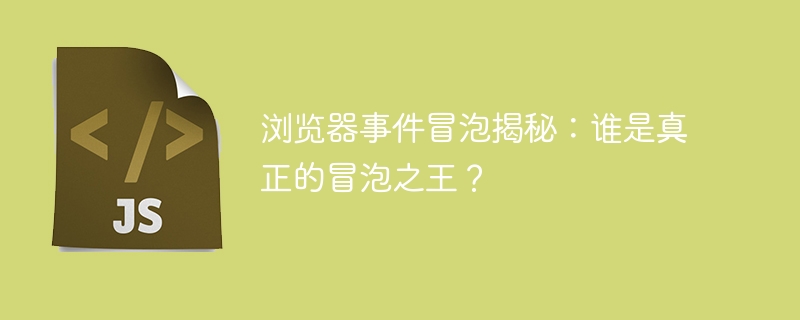Home >Web Front-end >JS Tutorial >Demystifying browser event bubbling: Who can be called the king of bubbling?
Demystifying browser event bubbling: Who can be called the king of bubbling?
- WBOYWBOYWBOYWBOYWBOYWBOYWBOYWBOYWBOYWBOYWBOYWBOYWBOriginal
- 2024-02-19 16:54:06498browse

Browser event bubbling revealed: Who is the real king of bubbling?
When we use browsers daily, we often encounter various interactive events, such as clicks, mouse movements, keyboard input, etc. After these events are triggered, they will go through a series of propagation processes, which is called event bubbling. Among the many browsers, who is the real king of bubbling? This article will reveal the principle of browser event bubbling and the behavioral differences of different browsers.
In the browser, a page is usually composed of multiple nested HTML elements. These elements may be a parent-child relationship or a sibling relationship. When an event is triggered on an element, the event will bubble up until it reaches the root node of the DOM tree. This is the process of event bubbling. During the bubbling process, the parent element will trigger the same event before the child element, thereby realizing event propagation and processing.
Different browsers handle event bubbling differently. When the traditional Internet Explorer (IE) browser propagates events in the order from child elements to parent elements, that is, first Trigger the event handler function of the child element, and then trigger the event handler function of the parent element. Other modern browsers (such as Chrome, Firefox, etc.) use the reverse order, that is, the event handler of the parent element is triggered first, and then the event handler of the child element is triggered.
This behavior difference brings some trouble to developers, especially when parent and child elements need to be nested. In order to solve this problem, developers can use event capture, that is, during the event propagation process, the event processing function on the root node is first triggered, and then propagated down to specific elements step by step. By specifying the third parameter of the event processing function as true, the event capture mode can be turned on.
In addition to event capturing and bubbling, the browser also provides a blocking mechanism for event triggering, which uses the methods of the event object to prevent the default behavior of the event or cancel the further propagation of the event. During the bubbling process, you can prevent the event from continuing to bubble by calling the stopPropagation() method of the event object, and calling the preventDefault() method can cancel the default behavior of the event.
In practical applications, the event bubbling mechanism provides us with a lot of convenience. Sometimes we only need to bind an event handling function to the parent element to monitor and process events for all child elements. This greatly simplifies writing and maintaining code. At the same time, event bubbling can also help us implement event proxies, that is, bind the event processing function to the parent element, and perform corresponding processing by judging the target element of the event, avoiding the need to bind event processing functions to each child element. Complex operations.
However, due to differences in the event bubbling behavior of different browsers, in order to ensure the compatibility of code in different browsers, developers must carefully handle the order of event propagation. You can use a compatibility library (such as jQuery) to unify the event handling behavior of different browsers, or ensure the stability of the code in different browsers through sufficient testing and debugging.
To sum up, browser event bubbling is an important interaction mechanism. Through the propagation and processing of events, it achieves unified monitoring and operation of multiple nested elements. During the event bubbling process, different browsers have different behaviors. Developers need to pay attention to the order in which events are processed, and use event capture and blocking mechanisms in a timely manner to implement more complex application requirements. At the same time, fully understanding and utilizing the event bubbling mechanism can bring developers a more efficient and convenient development experience.
The above is the detailed content of Demystifying browser event bubbling: Who can be called the king of bubbling?. For more information, please follow other related articles on the PHP Chinese website!

